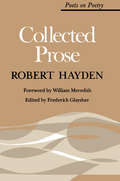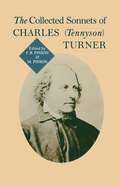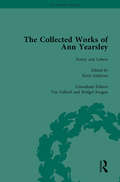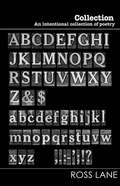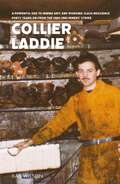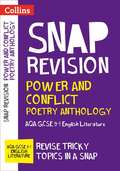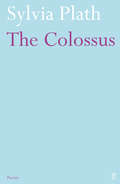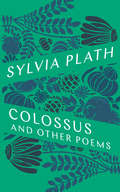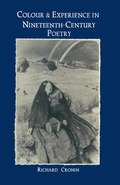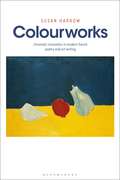- Table View
- List View
Collected Prose (Poets On Poetry)
by Robert Hayden"A collection of essays on poetry and the experiences that influenced poet Robert Hayden. Contents include "The History of Punchinello: A Baroque Play in One Act," Hayden's introductory remarks to volumes like Kaleidoscope: Poems by American Negro Poet and The New Negro, and interviews with Hayden."
Collected Verse (Oxford World's Classics)
by Paul Val?ry'The wind is rising!... Let us try to live!' One of the preeminent intellectuals of modern French culture, Val?ry is widely considered one of the country's greatest poets of the twentieth century. Following a flurry of sonnets in his late teens, he abruptly abandoned verse for twenty years. If the publication of The Young Fate in 1917 won him immediate and immense acclaim, his status as the outstanding poet of the era was firmly consolidated with the Album of Early Verse and Charms with its beautiful meditation on mortality, 'The Graveyard by the Sea', considered one of the finest poems in French. A classical voice in an era of avant-garde modernism, Val?ry's often sensuous work was inspired by mysticism, myth, the Mediterranean, and above all passionate love. This bilingual edition brings together for the first time the complete verse with many unknown and previously unpublished poems taken from his abundant correspondence, which offers intimate insight into a private side of the writer.
Collected Verse (Oxford World's Classics)
by Paul Val?ry'The wind is rising!... Let us try to live!' One of the preeminent intellectuals of modern French culture, Val?ry is widely considered one of the country's greatest poets of the twentieth century. Following a flurry of sonnets in his late teens, he abruptly abandoned verse for twenty years. If the publication of The Young Fate in 1917 won him immediate and immense acclaim, his status as the outstanding poet of the era was firmly consolidated with the Album of Early Verse and Charms with its beautiful meditation on mortality, 'The Graveyard by the Sea', considered one of the finest poems in French. A classical voice in an era of avant-garde modernism, Val?ry's often sensuous work was inspired by mysticism, myth, the Mediterranean, and above all passionate love. This bilingual edition brings together for the first time the complete verse with many unknown and previously unpublished poems taken from his abundant correspondence, which offers intimate insight into a private side of the writer.
The Collected Works of Ann Yearsley Vol 1: Poetry And Letters
by Kerri Andrews Tim Fulford Bridget KeeganPresents the works of Ann Yearsley, a laboring-class poet' whose writing forms part of an under-represented area of romanticism. This work includes her play "Earl Goodwin" and novel "The Royal Captives".
The Collected Works of Ann Yearsley Vol 1
by Kerri Andrews Tim Fulford Bridget KeeganPresents the works of Ann Yearsley, a laboring-class poet' whose writing forms part of an under-represented area of romanticism. This work includes her play "Earl Goodwin" and novel "The Royal Captives".
Collected Works of Paul Valery, Volume 1: Poems (PDF)
by Paul Valéry James R. LawlerPoems ranging from "La Jeune Parque" and "Le Cimetière marin" to occasional and light verse written as letters to friends, dedications in books, and inscriptions on ladies' fans demonstrate the wide scope of Valéry's lyric preoccupation. The bilingual edition, with David Paul's English translations facing the French texts, includes the autobiographical "Recollection," quoted below, and excerpts on poetry, selected and translated from Valéry's notebooks by James Lawler.Paul Valéry turned to the discipline of poetry during the First World War, to escape from the "commotion of a world gone mad." "I fashioned myself a poetry," he wrote, "that had no other law than to establish for me a way of living with myself, for a part of my days."Originally published in 1971.The Princeton Legacy Library uses the latest print-on-demand technology to again make available previously out-of-print books from the distinguished backlist of Princeton University Press. These editions preserve the original texts of these important books while presenting them in durable paperback and hardcover editions. The goal of the Princeton Legacy Library is to vastly increase access to the rich scholarly heritage found in the thousands of books published by Princeton University Press since its founding in 1905.
Collected Works of Paul Valery, Volume 11: Occasions (PDF)
by Paul Valéry Jackson MathewsThis collection of Valéry's occasional pieces—speeches, interviews, articles—shows him very much as the public figure, the first in demand when an "occasion" needed a prominent person. Included are his speech before the French Academy on his reception into that body; his address welcoming Marshal Petain to membership in the French Academy; a witty and appealing commencement address to the young ladies of a private school; memorial addresses honoring Emile Verhaeren and Henri Bremond; an article on the "Future of Literature," and an incisive piece on the eponymous heroine of Racine's Phèdre.Because Valéry spoke on many current educational and social problems in France, Occasions will be of considerable interest to students of modern European history as well as to those concerned with French literature and drama.Originally published in 1970.The Princeton Legacy Library uses the latest print-on-demand technology to again make available previously out-of-print books from the distinguished backlist of Princeton University Press. These editions preserve the original texts of these important books while presenting them in durable paperback and hardcover editions. The goal of the Princeton Legacy Library is to vastly increase access to the rich scholarly heritage found in the thousands of books published by Princeton University Press since its founding in 1905.
Collected Works of Paul Valery, Volume 14: Analects (PDF)
by Paul ValéryGrouped together in this book are several smaller volumes and plaquettes in which Valéry had published selections of his shorter prose writings: aphorisms, moral reflections, poetic observations, flashes of wit or fancy, even jokes—a variety of remarks and impressions, many of them first recorded in his Notebooks.Originally published in 1970.The Princeton Legacy Library uses the latest print-on-demand technology to again make available previously out-of-print books from the distinguished backlist of Princeton University Press. These editions preserve the original texts of these important books while presenting them in durable paperback and hardcover editions. The goal of the Princeton Legacy Library is to vastly increase access to the rich scholarly heritage found in the thousands of books published by Princeton University Press since its founding in 1905.
Collected Works of Paul Valery, Volume 2: Poems in the Rough (PDF)
by Paul Valéry H. CorkeIncludes some of Valéry's finest strokes of imagination, Broken Stories; some of his wittiest observations, Mixtures, Poems in the Rough; and even two of his great poems, Parables and The Angel—all written in the form of prose.Originally published in 1970.The Princeton Legacy Library uses the latest print-on-demand technology to again make available previously out-of-print books from the distinguished backlist of Princeton University Press. These editions preserve the original texts of these important books while presenting them in durable paperback and hardcover editions. The goal of the Princeton Legacy Library is to vastly increase access to the rich scholarly heritage found in the thousands of books published by Princeton University Press since its founding in 1905.
Collected Works of Paul Valery, Volume 9: Masters and Friends
by Paul Valéry Jackson MathewsThis is an informal collection of essays and speeches on the writers who in one way or another counted for Valéry in the shaping of his mind or in his affections and interests: Descartes, Voltaire, Stendhal, Goethe, Villon, Nietzsche, Pascal, Proust, Huysmans, Pierre Louÿs, Nerval, Rilke, Bergson, and others. The volume presents, in an appendix, the first publication in English of any extensive selection from Valéry's personal notebooks--the Cahiers.Originally published in 1968.The Princeton Legacy Library uses the latest print-on-demand technology to again make available previously out-of-print books from the distinguished backlist of Princeton University Press. These editions preserve the original texts of these important books while presenting them in durable paperback and hardcover editions. The goal of the Princeton Legacy Library is to vastly increase access to the rich scholarly heritage found in the thousands of books published by Princeton University Press since its founding in 1905.
The Collected Writings of Edward Rushton: (1756–1814) (Liverpool English Texts and Studies #65)
by Edward RushtonThe edition brings together the known writings in poetry and prose of Edward Rushton (1756--1814). Blinded by trachoma after an outbreak on the slaving ship in which he was a young officer, Rushton returned to Liverpool to scratch a living as a publican, newspaper editor, and finally bookseller and publisher. In his day Rushton was a well-known Liverpool poet and reformer, with an impressively wide range of causes (the Liverpool Blind School, the Liverpool Marine Society, and many radical political groups). Many of his songs, particularly the marine ballads, were very familiar in Britain and America. In the later Victorian period, as a particular version of romanticism began to dominate literary sensibilities, Rushton’s overt politics fell from favour and he became rather obscure, at least by comparison with his like-minded (but much better off) friend William Roscoe. As the history of slavery abolition and other radical causes has come to be re-examined, the bicentenary of Rushton’s death, falling in November 2014, has suggested an opportunity to take a new look at his remarkable career and impressive body of work. There has never been a critical edition of Rushton’s poems. His own 1806 edition omits much, including what is his best-known work in modern times, the anti-slavery West-Indian Eclogues of 1787; the posthumous 1824 edition omits much from the 1806 collection while drawing in other work. The present edition works from the earliest datable sources, in newspapers, chapbooks, periodicals, and broadsides, providing a clean text with significant revisions and variants noted in the commentary. Unfamiliar words are glossed, and brief introductions and contextual commentaries, informed by the latest scholarship, are given for each piece of writing.
Collection: An Intentional Collection of Poetry (Wordcatcher Modern Poetry)
by Ross LaneThere is rarely an end to a collection, itself being the action or process of collecting someone or something into a place to be cherished, observed, reviewed and displayed. This is my first intentional collection of poetry, a selection of work that gathers further memories of people, places, events and dreams. This book is about ownership, and the responsibility we have to our own course when sailing even the wildest seas of ageing, it is the duty of responsibility to our younger, hopeful selves who dreamed and willed us to deliver their future but have yet to face the challenges that life will deal us.
A Collection of Ballads
by Andrew LangAndrew Lang is known for being a poet, novelist, literary critic, and student of anthropology. He is most famous for his folk stories and fairy tales. "Poetry begins, as Aristotle says, in improvisation. <P> <P> Every man is his own poet, and, in moments of strong motion, expresses himself in song. " Lang goes on to say that poetry was once looked at only in a local sense but now poetry from all over the world is compared and studied. Ballard may evolve into fairy tales and from there into a more advanced literary work. The ballads in this collection were chosen for their romantic charm and for the Border raids they record. A few of the ballads in this work include. Sir Patrick Spens -- Battle Of Otterbourne -- Tam Lin -- Thomas The Rhymer -- "Sir Hugh; Or The Jew's Daughter" -- Son Davie! Son Davie! -- The Wife Of Usher's Well -- The Twa Corbies -- The Bonnie Earl Moray -- Clerk Saunders - and Waly, Waly.
Collier Laddie
by Rab WilsonForty years on from the 1984–85 UK Miners' Strike, the largest union-led industrial action in the 20th century, Rab Wilson – a former miner deeply entrenched in the strike – delivers a powerful narrative through his mining poems and strike diary, addressing contemporary social and economic issues in Scotland and the UK then and now. Having toiled in Scotland's mining industry for eight years, Rab provides an authentic voice that resonates with the struggles faced during the strike, vividly captured from his involvement between 12 March 1984 and 5 March 1985. This book serves as a testament to the working-class struggle, offering a unique perspective on the historical significance of Scotland's mining industry, skillfully expressed by a poet intimately connected to it. Rab Wilson emerges as an essential chronicler, ensuring the legacy of the miners' challenging strike endures in the pages of this evocative and timely work. Collier Laddie is an ode to resilience, solidarity and the enduring legacy of those who fought for justice during a pivotal moment in industrial history.
Collins GCSE Grade 9-1 SNAP Revision — AQA POETRY ANTHOLOGY POWER AND CONFLICT REVISION GUIDE: Ideal For Home Learning, 2022 And 2023 Exams (Collins Gcse Grade 9-1 Snap Revision Ser.)
by Collins GcseThe Colossus: And Other Poems (Vintage International Ser.)
by Sylvia PlathOriginally published in 1960, The Colossus was the only volume of Sylvia Plath's poetry published before her death in 1963. Showing a scholarly dedication to the craft, the poems in this collection are brimming with originality and the startling imagery that would later confirm her status as one of the most important poets of the twentieth century. 'On every page, a poet is serving notice that she has earned her credentials and knows her trade.' Seamus Heaney 'She steers clear of feminine charm, deliciousness, gentility, supersensitivity and the act of being a poetess. She simply writes good poetry. And she does so with a seriousness that demands only that she be judged equally seriously . . . There is an admirable no-nonsense air about this; the language is bare but vivid and precise, with a concentration that implies a good deal of disturbance with proportionately little fuss.' A. Alvarez in the Observer
The Colossus and Other Poems: And Other Poems (Vintage International)
by Sylvia PlathWith this startling, exhilarating book of poems, which was first published in 1960, Sylvia Plath burst into literature with spectacular force. In such classics as "The Beekeeper's Daughter," "The Disquieting Muses," "I Want, I Want," and "Full Fathom Five," she writes about sows and skeletons, fathers and suicides, about the noisy imperatives of life and the chilly hunger for death. Graceful in their craftsmanship, wonderfully original in their imagery, and presenting layer after layer of meaning, the forty poems in The Colossus are early artifacts of genius that still possess the power to move, delight, and shock.Penguin Random House Canada is proud to bring you classic works of literature in e-book form, with the highest quality production values. Find more today and rediscover books you never knew you loved.
Colour and Experience in Nineteenth-Century Poetry
by Richard CroninIn this book colour words as used in the poetry of Keats, Browning and Hopkins become crucial indicators of a way of looking at the nineteenth-century world. The author traces the forging of language that mediates between a system of values and the flux of experience.
The Colour of Black and White: Poems 1984-2003
by Liz LochheadThe Colour of Black and White is Liz Lochhead's first collection of poems for more than a dozen years, and, for her, the most important since the award-winning Dreaming Frankenstein and Collected Poems in 1984. The poems within this remarkable collection are often poems of love or death and iconic figures, Jungian archetypes, animus figures with strong outlines, harsh comfort and, often, voices of their own which dominate the first, the 'title', section of the book. Here you can find poems that are both autobiographical or entirely fictional set in Liz Lochhead's native rural/industrial Lanarkshire. There are also poems dedicated to other poets and a section of the rude and the rhyming, the out-loud, boldly revealing Lochhead's interest in 'unrespectable' poetry, in black prison 'toasts', in recitations, folk-poems and music hall monologues. The colour of both the black and the white. The collaboration with the printmaker Willie Rodger was also an essential part of the making of this book. Lochhead, long an admirer of Rodger's work, felt strongly that he was a kindred spirit and his poetically pared down and essential lino cuts accentuate the positive and the negative, the black and the white.
Colourworks: Chromatic Innovation in Modern French Poetry and Art Writing
by Susan HarrowHow do modern writers write colour? How do today's readers respond to the invitation to 'think colour' as they read poetry and art writing, and explore paintings? To what extent can critical thought on colour in visual media illuminate the textual life of colour? These are some of the lines of enquiry pursued in this bold new study of modern poetry and art writing in French, where colour, Susan Harrow argues, is integral to the exploration of ethics, ekphrasis, objects, bodies, landscape and interiority.The question of colour, in a variety of disciplines and media, has provoked debate from Aristotle to Goethe, and from Baudelaire to Derek Jarman. If the past twenty years have witnessed a 'colour turn' in contemporary cultural studies and screen research, colour values in literary and textual media are often elided or, simply, overlooked. Colourworks tackles this lacuna in the study of modern poetry and art writing in French, revealing the integral role of colour in the work of three iconic French writers in the modern tradition: Stéphane Mallarmé, Paul Valéry and Yves Bonnefoy. This book spans the broad modern period from the 1860s to the early twenty-first century in taking an exploratory approach to the visuality of the verbal medium through an adventurous reading of text and image. Harrow uncovers how colour moves and morphs in texts as it challenges the traditionalist containments of chromatic symbolism. Beyond its primary area of investigation in modern poetry and art writing in French, this richly colour-illustrated study has significant interdisciplinary implications-conceptual, methodological, and practical-for the study of visuality in humanities research, from literature studies to material and visual culture studies.
Colourworks: Chromatic Innovation in Modern French Poetry and Art Writing
by Susan HarrowHow do modern writers write colour? How do today's readers respond to the invitation to 'think colour' as they read poetry and art writing, and explore paintings? To what extent can critical thought on colour in visual media illuminate the textual life of colour? These are some of the lines of enquiry pursued in this bold new study of modern poetry and art writing in French, where colour, Susan Harrow argues, is integral to the exploration of ethics, ekphrasis, objects, bodies, landscape and interiority.The question of colour, in a variety of disciplines and media, has provoked debate from Aristotle to Goethe, and from Baudelaire to Derek Jarman. If the past twenty years have witnessed a 'colour turn' in contemporary cultural studies and screen research, colour values in literary and textual media are often elided or, simply, overlooked. Colourworks tackles this lacuna in the study of modern poetry and art writing in French, revealing the integral role of colour in the work of three iconic French writers in the modern tradition: Stéphane Mallarmé, Paul Valéry and Yves Bonnefoy. This book spans the broad modern period from the 1860s to the early twenty-first century in taking an exploratory approach to the visuality of the verbal medium through an adventurous reading of text and image. Harrow uncovers how colour moves and morphs in texts as it challenges the traditionalist containments of chromatic symbolism. Beyond its primary area of investigation in modern poetry and art writing in French, this richly colour-illustrated study has significant interdisciplinary implications-conceptual, methodological, and practical-for the study of visuality in humanities research, from literature studies to material and visual culture studies.
Columbarium (Phoenix Poets)
by Susan StewartWinner of the 2003 National Book Critics Circle Award in the category of poetry. In her long-awaited fourth book of poetry, Susan Stewart gives us a series of splendid, numinous poems about truths learned with the mind but set free through the senses. Modeled on the seventeenth-century practice of century forms, or books of one hundred pages, Columbarium expresses the bond between the living and the dead in voices of parent to child, lover to beloved, and mortal to the gods. The book arrives as a meditative gift from one of our most respected poet-critics. Stewart frames her Columbarium with four poems paying homage to the elements-to their destructive and creative aspects and to their roles in the human and more than human worlds. Both nest and crypt, the book's center holds an alphabet of "shadow georgics," poems of instruction and doubt that link knowledge and the unconscious. Questions of mortality, of goodness and suffering, and of the fragility and power of memory animate these poems. In one poem an apple calls the narrator back from the dead to savor the echoes of its varieties in myth and literature. In another, the seeds of a pear tree reveal the essential unity that makes the diversity of existence possible. Stewart's Columbarium is both a memorial to the dead and a testament to life.
Columbarium (Phoenix Poets)
by Susan StewartWinner of the 2003 National Book Critics Circle Award in the category of poetry. In her long-awaited fourth book of poetry, Susan Stewart gives us a series of splendid, numinous poems about truths learned with the mind but set free through the senses. Modeled on the seventeenth-century practice of century forms, or books of one hundred pages, Columbarium expresses the bond between the living and the dead in voices of parent to child, lover to beloved, and mortal to the gods. The book arrives as a meditative gift from one of our most respected poet-critics. Stewart frames her Columbarium with four poems paying homage to the elements-to their destructive and creative aspects and to their roles in the human and more than human worlds. Both nest and crypt, the book's center holds an alphabet of "shadow georgics," poems of instruction and doubt that link knowledge and the unconscious. Questions of mortality, of goodness and suffering, and of the fragility and power of memory animate these poems. In one poem an apple calls the narrator back from the dead to savor the echoes of its varieties in myth and literature. In another, the seeds of a pear tree reveal the essential unity that makes the diversity of existence possible. Stewart's Columbarium is both a memorial to the dead and a testament to life.
